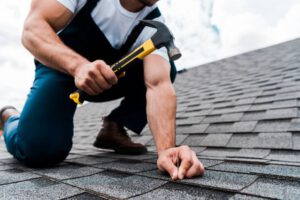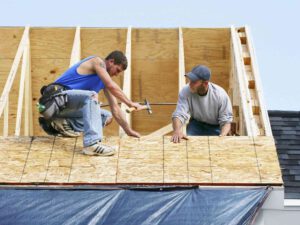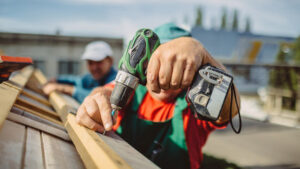Most homeowners only know their roof needs repairs once something goes wrong. To avoid this, schedule regular ground-level inspections and make sure your homeowner’s insurance covers any damage caused by storms or natural disasters. For more information visit Roofing Longview TX.
Look for missing shingles, small holes, cracks, and dents on air conditioning units or lawn furniture and flashing around chimneys or roof windows. If you see these problems, they should be addressed as soon as possible to prevent more costly damage.

Shingles are the outermost layer of your roof and take the brunt of most weather-related damage. Because of this, shingle repairs are among the most common types of roof repair. Repairing shingles can be costly, but it’s often cheaper than replacing your entire roof or dealing with other serious roofing problems.
Generally, a roof’s structural integrity and overall performance are greatly improved by healthy, well-installed shingles. Shingles can resist moisture and deflect harmful sun rays. Additionally, shingle material is fireproof, which helps to add another layer of security and safety to your home.
When a shingle is damaged, it’s important to repair the problem immediately to prevent water from seeping under the shingles and rotting the wood sheathing beneath. Ignoring shingle problems can result in expensive water leaks that can seriously damage your home.
While some people attempt DIY shingle repair, a roofing professional will ensure your roof is properly secured to avoid future problems. A professional can also help you decide if a complete roof replacement is the best option.
A quality asphalt shingle is an excellent choice for a roof because it’s resistant to damage caused by hail, high winds, and other environmental factors. Asphalt shingles are also available in various colors and styles, making it easy to match your existing aesthetic.
In terms of cost, a shingle repair can vary widely depending on the extent of the work required to resolve the issue. Is the problem confined to one small section of your roof, or is there a wider underlying issue that needs to be addressed? Generally, the more extensive the shingle repair project is, the higher the associated costs.
Regardless of your roofing system type, a typical shingle repair costs between $250 and $10,000. This includes the cost of the materials and labor to fix the shingle damage and any other roofing-related repairs that may be needed. The price of a roof repair will depend on the extent of the damage, and it’s important to know what to expect before you get started.
Flashing is a thin material, often made of metal, used to seal or protect roof areas where different materials meet or intersect. These include the areas where the wall of a house meets the roof, valleys, and protrusions such as vents or skylights. The primary function of roof flashing is to prevent water from entering a home and damaging the underlying structure.
A trained roofing professional can inspect a roof’s flashing to spot potential issues and address them before they cause significant damage. However, homeowners can also take some steps to check for flashing problems, including:
Look for damaged or missing flashing. Damaged flashing is more likely to leak, especially if it has developed holes or blisters. Small holes up to 3/4 inches can be patched using roofing cement and a piece of the same flashing material.
If a hole is large or the flashing is worn out, it may need to be replaced. Replacing roof flashing is a much larger job than repairing individual shingles, but it’s essential for keeping your home and its occupants safe from the elements.
Consider upgrading to durable materials for flashing. This will cost more upfront, but it can save you money in the long run by reducing the frequency of required repairs.
Inspect your roof regularly for signs of flashing problems. This can be done from the inside of your home by checking the attic or from the outside by walking around the perimeter of your house with a pair of binoculars.
If you find any signs of leaking, consider immediately scheduling a repair. Left untreated, flashing leaks can cause rotted framing and sheathing, destroyed insulation, and ruined ceilings. Getting the problem fixed right away can save you a lot of trouble.
Like any other protrusion in a roof, chimneys require flashing to protect the area between the flue and the roofing materials. Chimney flashing is generally made from thin pieces of metal placed over the joints between the chimney and the shingles, forming a watertight seal to prevent rain from seeping in and damaging the structure below. Chimney flashing is prone to deterioration due to age, extreme weather conditions, and accidents that can damage the sealant.
As a result, chimney leaks are common problems homeowners face. These leaks may manifest as water in the fireplace or appear on the ceiling or walls near the chimney. The problem with chimney leaks is that they often lead to other roof issues, including shingle damage that needs to be addressed by a professional roofer. This is why it’s important to call a roofer first and let them inspect and repair any chimney issues before they progress to the point where the leaking affects the shingles.
The most serious chimney issues can be caused by a broken crown or a flue liner in disrepair. Depending on the severity of the problem, it may be necessary to replace the entire chimney structure itself.
In most cases, a chimney repair specialist must remove the chimney and replace the flashing before making any other repairs. This can be a difficult task requiring a lot of skill and knowledge, so if you’re experiencing chimney issues, it’s best to call the professionals as soon as possible.
In addition to a chimney cap, a chimney should also have a cricket, a ridge that extends from the top of the chimney to the slope of the roof and helps shed rain away from the chimney. The flue lining is a pipe inside the chimney that carries smoke and vapors. It can be rigid or flexible and must be in good condition to protect the house from the fire’s byproducts. Chimney liners are not easily repaired and should only be replaced if damaged.
Gutters are long troughs that run along the edge of your roof to catch rainwater and channel it through downspouts to the ground, away from the house. They protect your home’s foundation from water damage by keeping it from pooling around the structure. Without gutters, water cascades in heavy sheets off the roof, eroding soil and battering tender plants and flowers. It can also saturate the soil around your house, weakening the foundation and contributing to basement flooding and leaky crawl spaces.
You can get a good idea of the condition of your gutters from the outside, but you’ll want to venture up into the attic or crawl space if there is one to inspect the inside of your gutters. Look for rust spots, holes, and other signs of wear and tear. If any of the fasteners are missing or loose, they should be repaired as soon as possible to prevent further water damage to your roof and the rest of the house.
If the gutters are sagging, you may need to add additional support. The most common type of support is the spike-and-ferrule style, which consists of a long spike that passes through the gutter and a metal tube that holds it in place. These are generally hammered into the fascia board or wood cornice. You can also use rolled flashing, which is available at most home centers and comes in 6-in. x 10-ft. aluminum rolls. Cut the flashing to size, remove the paper backing, and adhere it to the gutter, pressing firmly and working curves and corners into shape. Overlap any seams by at least one inch and extend the end of the tape four inches.
You’ll also want to check for ice dams, which form when snow melts and re-freezes at the eaves and in the gutters. This can lead to leaks in the roof shingles over the eaves and cause other problems with your gutter system. Keeping the gutters free of debris and properly aligned should help prevent ice dams, and improving attic insulation and ventilation will also help.

